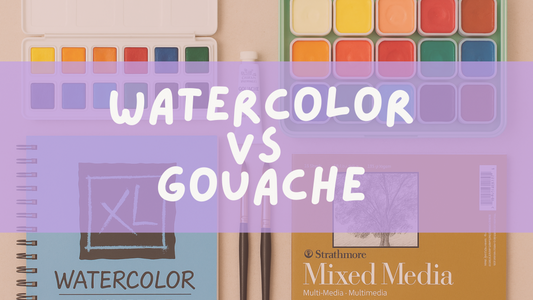Whether you're an artist, surface designer, or creative hobbyist, printing your artwork onto fabric opens up a whole new world of possibilities—from custom apparel and accessories to home decor and textiles. But how do you actually get your art onto fabric?
In this post, I'll walk you through several popular options that I've explored for my shop, including DIY methods you can try at home, print-on-demand services like Printful, and fabric-specific platforms like Spoonflower.
Note: All links are for products that I've used in the past. I do earn an affiliate commission for items purchased, which helps me fund and continue this free blog of resources for artists and budding entrepreneurs!
1. DIY at Home: Heat Press
If you want to be hands-on and maintain full control over the process, printing at home can be incredibly rewarding. Two of the most common methods are using a heat press or screen printing.
Heat Press Transfer
A heat press machine lets you transfer your artwork—usually printed with special sublimation ink or transfer paper—directly onto fabric using heat and pressure. This method is ideal for cotton t-shirts, tote bags, and small runs of printed goods.
What You’ll Need:
- Heat press machine (or just use an iron for smaller projects!)
- Inkjet printer with sublimation or pigment ink
- Heat transfer paper - Tip: Make sure to use a heat transfer paper made specifically dark materials if you're trying to transfer artwork on dark or colored fabrics, otherwise regular heat transfer paper is only good for white or light fabrics
- Fabric of blank items
- Design software (like Photoshop or Procreate)
Here's a great starter heat press for first timers:
Pros:
- Great for one-off projects or small batches, where you can test multiple designs
- No minimum order quantities - you can make them as you go!
- Works well for garments, bags, and home textiles
- Great for recreating exact artwork
Cons:
- Limited to heat-compatible materials/fabrics
- Requires some upfront investment in equipment
- Not ideal for bulk production
Need the full list of products I recommend for heat transfers? Checkout my Amazon List!
Screen Printing
Screen printing involves pushing ink through a mesh screen onto fabric, one color at a time. It's perfect for bold, graphic designs with limited color palettes.
What You’ll Need:
- Screen printing frame and mesh
- Squeegee
- Fabric ink
- Emulsion and exposure unit (or use pre-burned screens)
- Your artwork in high-contrast black and white
Pros:
- High durability and wash-fastness
- Beautiful, vibrant prints
- Cost-effective for larger runs
Cons:
- SUPER steep learning curve, which leads to materials waste
- Time-consuming for multicolor designs as you'll have to mix your own colors
- Can't do exact recreations of artwork you've done in the past, especially if they are complex colors or have textures or gradients.
- Messy (but fun!)
Looking to get materials for your first screen printing project? Check out my Amazon recommendations for a starter kit for screen printing!
2. Print-on-Demand: Use a Drop-Shipping Supplier
If you're not keen on getting your hands dirty—or want to scale your art into products for sale—print-on-demand (POD) is your best friend. Services like Printful let you upload your artwork and have it printed onto everything from t-shirts and hoodies to throw pillows and tote bags.
How It Works:
- Upload your design to Printful
- Choose your product (e.g., shirt, pillow, blanket, tote, hat)
- Printful fulfills each order automatically as customers buy, whether it's from your own shop (whether you're using Shopify, Wix, WooCommerce, etc.) or a marketplace (Etsy, Amazon, etc.)

Pros:
- No need to hold inventory at home (that takes up a ton of space) or upfront costs
- Seamless integration with your online store
- Discounted samples before you add it to your store
- Professional quality printing and fulfillment
- Very little effort to start and maintain
- Some products have embroidery options
- Ability to do patterned "all-over" printing on fabric
Cons:
- Lower profit margins
- Less control over packaging and branding (unless you upgrade your service level, which cuts into the already low margins)
- Limited fabric types and cut/sew options
3. Custom Fabric Printing with Spoonflower
If your goal is to design and sell your own custom fabric, Spoonflower is the platform for you. It’s a favorite among surface pattern designers and textile artists who want to see their work come to life on yards of fabric or wallpaper.
How Spoonflower Works:
- Upload your repeat pattern or artwork
- Choose a fabric base (cotton, linen, canvas, etc.)
- Spoonflower prints and ships your custom fabric
You can also open a Spoonflower shop to sell your fabric designs, earning a commission on every sale.
Pros:
- Wide variety of fabric types and substrates (like wallpaper!)
- Ability to buy fabric by the yard for your own use (low minimums)
- Built-in marketplace for artists
- Excellent print quality for patterns
Cons:
- Higher cost per yard compared to bulk suppliers
- Requires seamless pattern knowledge
- Slower turnaround times
So, Which Method is Right for You?
| Goal | Best Option |
|---|---|
| One-off custom items or for small projects | Heat press at home |
| Bold, graphic apparel and totes. Great for large-format printing | Screen printing |
| Sell products online with little effort, just provide your designs! | Printful (Print-on-Demand) |
| Sell fabric by the yard or, if you're extra crafty, get custom fabric to sew merchandise on your own | Spoonflower |
Final Tips for Success
Color Management: Use CMYK color profiles and test swatches when possible to ensure color accuracy.
Resolution Matters: Always upload high-resolution files (300 DPI or more) for clean, crisp prints, whether you're printing for heat transfers or uploading images to outside vendors.
Mockups Sell: Whether you're DIYing or using POD, realistic product mockups help showcase your designs professionally. It makes a huge difference in trying to sell your designs!
Printing your art on fabric is not only fun—it’s empowering. Whether you’re outfitting your own studio or starting a creative business, there’s a printing method that fits your style and scale. Don’t be afraid to experiment and find what works for you!
Want to save this article? Pin the image below:









 https://kimposed.com/pages/about
https://kimposed.com/pages/about


